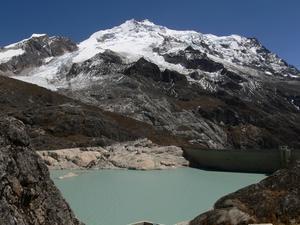Advertisement
Published: September 12th 2006

 Huayna Potosi
Huayna Potosi
The mountain to be climbedClimbing Huayna Potosi mountain is difficult mostly because of the altitude of the summit, where the barometric pressure is more than twice as low as on the sea level. This means twice less air! The climb itself is not technically demanding, so even people who has never done serious climbing before, like me, could attempt it.
The main thing here is acclimatization. You need to spend allot of time at high altitude, before attempting this climb.
And even if you're acclimatized enough, still every physical effort you'll do will be much more difficult at this altitude and you'll feel the lack of oxygen straight away.
On the first day of this 3 days climb, we arrived to the base camp at 4700 m, from where we went to a near glacier where we had fun practicing different techniques of ice climbing, and where we got accustomed to our gear.
The next day was much more challenging, as we had to carry all our equipment to the high camp at 5100 m, where we arrived pretty early, at about 4pm. Rock camp lies just below the permanent snow
line. There we were to rest and sleep until 1am the next day, when the actual part of ice and snow climbing was to begin.
Yeah, you read it right - We had to start our climb at unbelievable 1AM, because that's when the ice and snow conditions are optimal for climbing.
On the way to Rock camp we met a group of climbers on their way down, who started the climb one day before us, from the same climbing agency. They had bad news to tell us - they didn't manage to get to the summit. This was a bit discouraging, but then in the camp we met a 67 year old climber, who did many climbs before, and like us, was to attempt this one. Despite her age, she was probably in a much better physical shape than we were. This encouraged us - if she can do it - why can't we?
Needless to say it wasn't easy for me to fall asleep that early, so I had something like 4 or 5 hours of sleep.
Than the first 5 and a half hours of the climb were even harder. Most of the route went
at 30 degrees incline, accept few flat parts, and some short half vertical parts of about 50 degrees.
Than, at about 7am, we reached the ultimate part of the climb - an almost vertical wall of ice, 250 meters high, 55 degrees of incline.
This was a last test for our determination to get to the top. Some people decide not to continue beyond this point, seeing the threatening wall so high above them, and return defeated. But we did not! It took us almost an hour to get to the top, but we did it! We were between the 30%-40% lucky climbers to get to the summit! And it was an incredible feeling of satisfaction. The views of the sunrise from the top were stupendous.
Since we climbed up in the dark, we missed all the views, but on the way down we had a chance to appreciate them.
The different snow and ice formation, the lagunas way below, sometimes just snow and snow till the horizon were incredible, and although we were exhausted, we did appreciate this beauty.
Advertisement
Tot: 0.261s; Tpl: 0.014s; cc: 20; qc: 92; dbt: 0.1891s; 1; m:domysql w:travelblog (10.17.0.13); sld: 1;
; mem: 1.2mb

 Huayna Potosi
Huayna Potosi
 Getting ready for the practice
Getting ready for the practice








